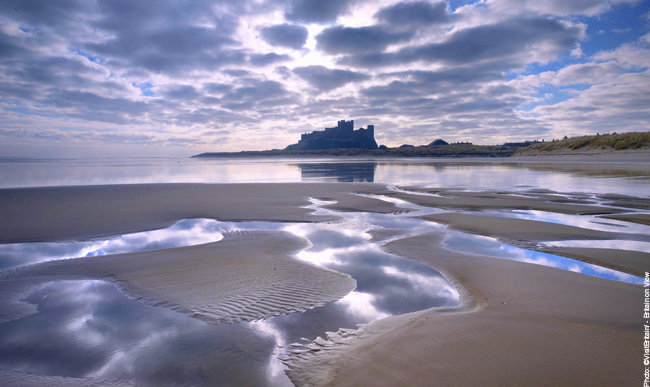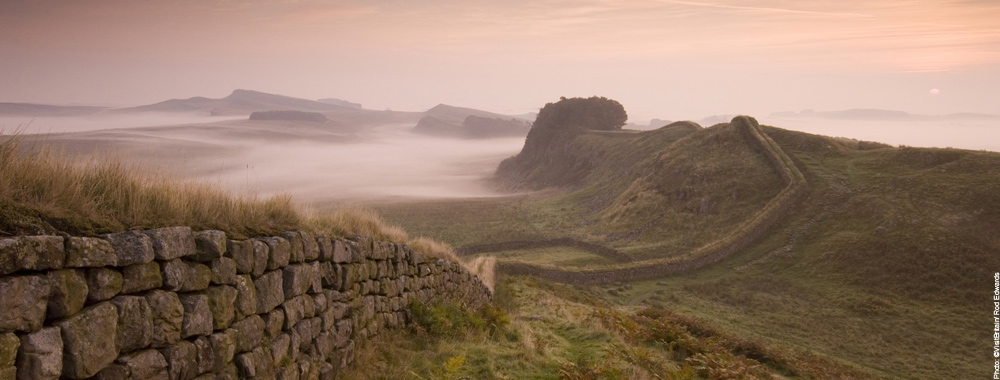
North East
With Northumberland’s rugged coastline, Yorkshire’s emerald dales and a collection of bustling cities, the North East of England is a trove of history and culture. Visit the crumbling foundations of Hadrian’s Wall to be transported back to Roman Britain, or sip champagne along Newcastle’s cosmopolitan Quayside to savour the North East’s more modern delights!
Due to its exposed location, Gateshead's giant steel sculpture, Angel of the North, has been anchored to rock 70 feet below the surface by 600 tonnes of concrete
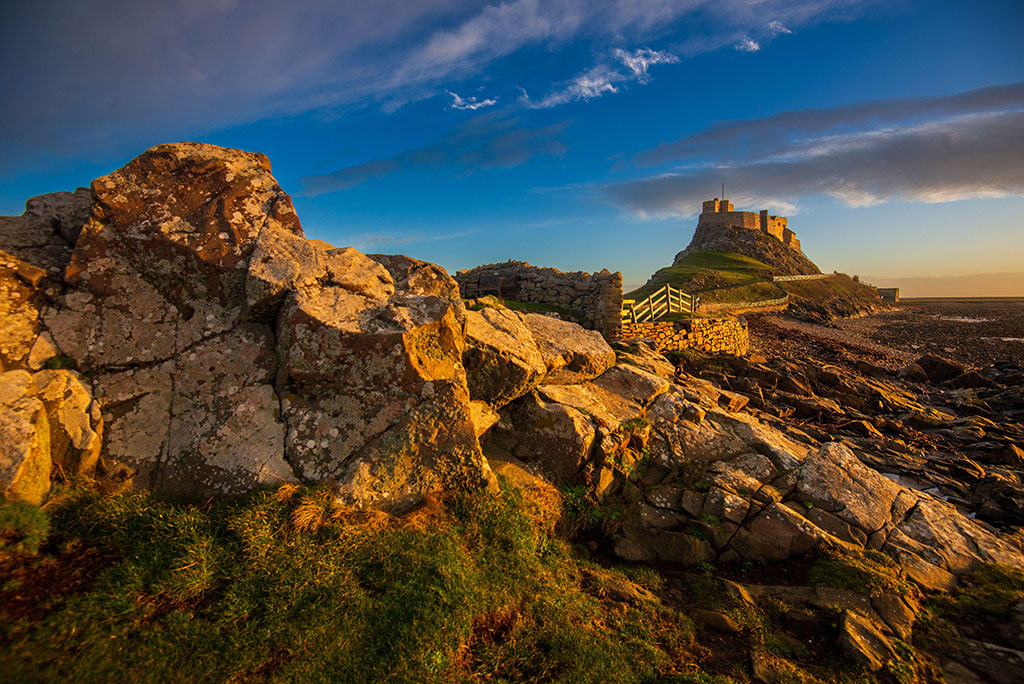
Lindisfarne: A history of Holy Island
Once the holiest site in Anglo-Saxon England, the beautiful tidal island of Lindisfarne is a haven for historians
Driving over the Lindisfarne causeway from the English mainland is one of the most memorable experiences you can have in Britain. From the moment you see the small tidal island for the first time from the Northumberland coast, with its majestic castle reigning supreme at one end, you’ll be in no doubt that Lindisfarne is one of the country’s most beautiful spots.
The island is easily accessible via road, although it’s cut off from the mainland twice a day during high tide (planning is essential to avoid being stranded). Once on the island you feel an age away from normal life. Most visitors come just for the day, so if you choose to stay longer you get a wonderful sense of having the entire island to yourself, apart from the friendly locals and the colonies of seals, of course.
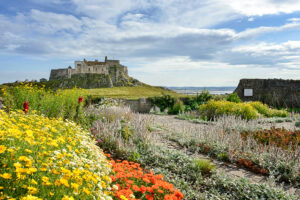
Also known as ‘Holy Island’, Lindisfarne was once the most sacred site in Anglo-Saxon England. St Aidan, an Irish monk from Iona, the centre of Christianity in Scotland, was invited by Oswald, the King of Northumbria, to convert his kingdom to Christianity. St Aidan founded Lindisfarne Monastery on Holy Island in 635 AD.
In the 670s, a monk named Cuthbert joined the monastery, and went on to become the most important northern English saint in the Middle Ages. Cuthbert lived as a hermit on a rock just off the beach by the Priory (visitors can easily walk to St Cuthbert’s Isle from the beach when the tide is out), before later moving to the remote island of Inner Farne.
When he died in 687 Cuthbert was buried in a stone coffin on the island, and eleven years later the monks opened his tomb and discovered that his body had not decayed. So began the cult of St Cuthbert, with miracles being reported at his shrine, and Lindisfarne became a major centre of pilgrimage. The monastery grew in power and wealth and became a hub of Christian learning, resulting in the production in the 8th century of the illuminated Latin manuscript, the Lindisfarne Gospels, now housed in the British Library.
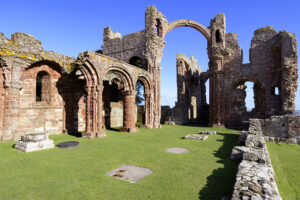
Its wealth meant that Lindisfarne Priory became a target for Viking raiders from the end of the 8th century. In fact, the attack on Lindisfarne on 8 June 793 AD is believed to be the first significant Viking attack in western Europe.
The monks abandoned the monastery and did not return for 400 years. In the 12th century it became an active religious site again, but was closed in 1537 during the Dissolution of the Monasteries. By the 18th century the Priory was in ruins, though it has remained a centre of pilgrimage.
Now looked after by English Heritage, Lindisfarne Priory has an excellent museum, with a brand-new display of never-before-seen Christian and Anglo-Saxon artefacts, including the first known rosary bead necklace, made from salmon vertebrae and found on a skeleton from Lindisfarne.
The island has its very own castle too. Despite being much smaller than the magnificent Bamburgh Castle, to which it looks out to over the causeway, Lindisfarne Castle has the same proud stance on its rocky island outcrop, and looks nothing short of magnificent at sunset.
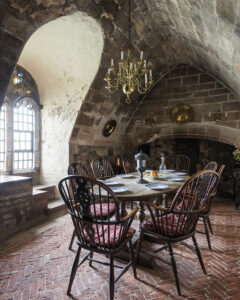
The castle was originally a 16th-century fort, and in 1901 Edward Hudson, the founder of Country Life magazine, took over the lease and commissioned the architect Edwin Lutyens and garden designer Gertrude Jekyll to work their magic. It is now a wonderful example of an Arts and Crafts house, with its original Elizabethan features carefully preserved.
No trip to the island is complete without a walk along the Lindisfarne National Nature Reserve, which, in addition to stunning stretches of beaches and dunes, is home to an abundance of protected wildlife, from wildfowl and wading birds to grey seals, which can regularly be spotted sunbathing on the sands. Keen walkers can walk around the entire island in around three hours.
If you’re in the market for a Holy Island souvenir, it doesn’t get more special than a bottle of Lindisfarne Mead. Although the island’s monks have been gone for 500 years, the mead that they perfected (a unique twist on traditional mead, using grapes blended with fermented honey) is still produced at St Aidan’s Winery on the island to an ancient recipe, infused in pure water drawn from the island’s ancient well.
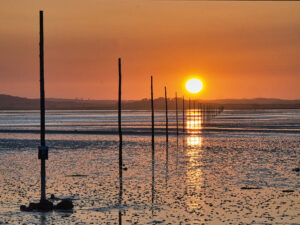
The result is a warming and delicious tipple that will leave you longing for another trip to this special place, where thousands of years of history seem to live on all around you.
This is an extract, read the full version in the May/June issue of BRITAIN, available to buy here from 7 April.
Read more:

Northumberland Castles
Northumberland is home to more castles than any other English county. We travel to England’s northernmost region to hear tales of theft, murder and spooky apparitions
Its location close to the Scottish border has meant that Northumberland has suffered a turbulent past, with pillaging from Border Reivers in the late Middle Ages and the constant threat of invading armies. For protection, Northumbrians built huge fortresses and today 70 or more of these castles dot the wild landscape, from haunting ruins to imposing palaces.
Very much a buffer between Scotland and England, Northumberland was first subjected to raids from the Vikings. Later, the bloody border wars saw Scottish kings capture castles and ravage the countryside. Berwick-upon-Tweed, just three miles from the Scottish border, has changed hands between the English and Scottish 13 times. It has been in English territory since 1482.
Berwick Castle
There’s not much left of medieval Berwick Castle, but the fortifications, which were added in the 16th century and updated in the 17th century, encircle the whole town and are seriously impressive. Take time to walk the complete circuit and look out for the Grade I listed Royal Border Bridge that spans the River Tweed. Designed by Robert Stephenson (son of ‘Father of the Railways’, George Stephenson), it includes 28 semi-circular arches and gently curves across the water to stunning effect.
Lindisfarne Castle
The prize for the most atmospheric castle in Northumberland must go to Lindisfarne, which sits on its own island and is accessible on foot at low tide. Sitting on a volcanic crag, Lindisfarne Castle (on the Holy Isle) is built on the site of a 7th-century monastery, founded by St Aidan and later presided over by St Cuthbert.
It was here in 793 that a raid on the monastery sent shockwaves through Europe as the Vikings unleashed an unprecedented attack on the sacred heart of the Northumbrian kingdom. The attack, which marked the start of a relentless campaign in England by the Vikings, was recorded at Lindisfarne in the 9th and 10th centuries in a religious sculpture known as the Domesday Stone, now displayed in Lindisfarne’s museum.
The castle was built during the reign of Henry VIII and was later developed in the Elizabethan era. Unlike many of Northumberland’s castles, Lindisfarne saw little action, being seized just once in 1715 during the Jacobite risings by supporters of James Stuart, the Old Pretender. It was soon recaptured. This spring Lindisfarne reopens following 18 months of restoration work. Marking the reopening is an installation by Turner-Prize-nominated artist Anya Gallaccio. Gallaccio was inspired by Gertrude Jekyll’s colourful geometric walled garden. Gertrude Jekyll created the garden in the early 20th century when her close friend, the Arts & Crafts pioneer Edwin Lutyens, was employed to turn Lindisfarne into a holiday home for Edward Hudson, the owner of Country Life magazine.
Bamburgh Castle
Back on the mainland, about 15 miles south of Lindisfarne, Bamburgh Castle is a beautifully restored fortress that was once the Royal Seat of the Kings of Northumbria and has been a family home since 1894.
A castle has stood guard over this stretch of coastline for more than 1,400 years, but it was with the arrival of the Saxons that it became one of the most significant sites in medieval England: a royal palace that numbered St Aidan, St Cuthbert and St Oswald among its guests.
In fact, the latter two are forever connected to the castle due to an enduring legend. The story goes that following the death of St Oswald, Cuthbert sent an old man to retrieve his head from Bamburgh. Oswald’s head was supposedly returned to Lindisfarne where it was kept as a relic for some time before being found in St Cuthbert’s coffin when it was opened in the 19th century.
Today, the castle displays the results of a thorough 18th-century restoration, and there are 14 State Rooms to explore, connected by a series of intriguing stairwells, corridors and passages.
Chillingham Castle
Just 13 miles inland of Bamburgh is 13th-century Chillingham Castle, which occupied a strategic position during the border wars. Its long list of royal guests includes King Henry III, Edward I and Charles I, who stayed here for three nights before he was imprisoned.
Chillingham’s medieval design remains spookily intact, fuelling the imaginations of visitors to what is supposedly Britain’s most haunted castle. Visitors report hearing the voices of two men in the chapel beside the Great Hall, while the pale figure of a lone woman that appears in the Inner Pantry is known as the White Pantry Ghost.
Perhaps most chilling of all is the ghost in the chamber, which is never seen but rather felt in the creepy and oppressive atmosphere. Ghost tours take place throughout the year.
Dunstanburgh Castle
Standing on a remote headland, it’s hard not to feel a sense of poignancy when you visit the remains of Dunstanburgh Castle. Dunstanburgh was built in 1313 by one of King Edward II’s most powerful barons, Earl Thomas of Lancaster at a time when relations between himself and the king had soured.
Lancaster may have built the castle as an act of open defiance against the king, rather than as a military stronghold. Whatever his thinking, when he later mounted a rebellion against the king he was captured and executed. The castle was also the scene of much bloodshed during the War of the Roses, twice being captured by Yorkists and later falling into ruin.
The best way to view the castle is on a coastal walk from the quaint fishing village of Craster – which also gives you the chance to sample their famous kippers (still prepared in the traditional oak-smoked barrels).
Alnwick Castle
A few miles south of Dunstanburgh inland lies a true majesty of castles: Alnwick, which withstood numerous sieges in its history, not least when it was captured by King David I of Scotland in 1136. Originally a Norman motte and bailey castle, Alnwick has evolved beautifully over the years, most significantly in the 18th century when it was transformed from a decaying fortress into a splendid palace. However, the high Gothic style was later replaced with a more authentic looking medieval border.
Alnwick has been the family seat of the Duke of Northumberland for centuries, and its current guise has earned it starring roles in two Christmas specials of Downton Abbey (as Brancaster Castle) and two Harry Potter films. Standout features include the Outer Bailey where Harry learned the rules of Quidditch in Harry Potter and the Philosopher’s Stone, and one of the best surviving barbicans (the outer defence of a castle or wall city) in Britain. Alnwick is also the second largest inhabited castle in England (after Windsor), and it takes a commanding position over the River Aln. Thank goodness King John’s order to demolish it in 1212, as revenge against a supposed plotter, was ignored.
Wherever you go in Northumberland the sense of history is palpable, but while these magnificent fortresses were once scenes of violence and twisted in fighting, today they are serene places to visit that offer a glimpse into the region’s unsettled past.
BOOK AHEAD
Berwick Castle
English Heritage looks after the castle ruins and rampart. Make sure you walk the town walls.
www.english-heritage.org.uk
Lindisfarne Castle
The atmospheric castle on Holy Isle finally reopens this spring after an 18-month renovation project.
www.nationaltrust.org.uk/lindisfarne-castle
Bamburgh Castle
Known as the King of Castles, Bamburgh is both an imposing fortress and family home.
www.bamburghcastle.com
Chillingham Castle
Considered the most haunted castle in Britain, visit Chillingham if you dare. You can even stay over if you don’t mind things going bump in the night.
www.chillingham-castle.com
Dunstanburgh Castle
The coastal walk from Craster to Dunstanburgh is well worth doing – look out for migrating birds en route.
www.nationaltrust.org.uk/dunstanburgh-castle
Alnwick Castle
The family seat of the Duke of Northumberland is the perfect place to channel your inner Harry Potter, or earl or countess.
www.alnwickcastle.com
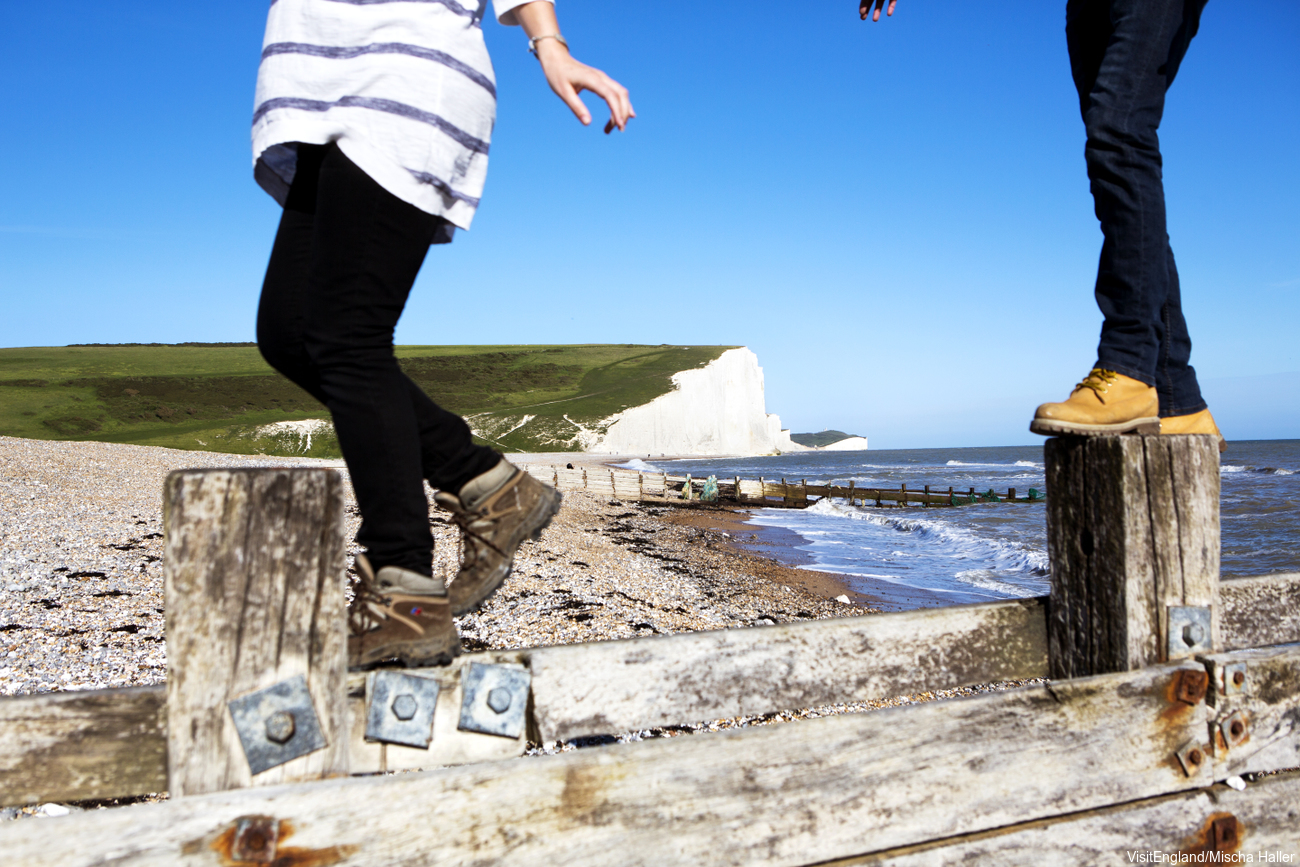
Best British destinations in October
October is often seen as an in-between month – it’s not quite winter, though summer is a distant memory. We’ve highlighted a few of the best British places to visit at this time of year
Isabella Plantation, Richmond Park
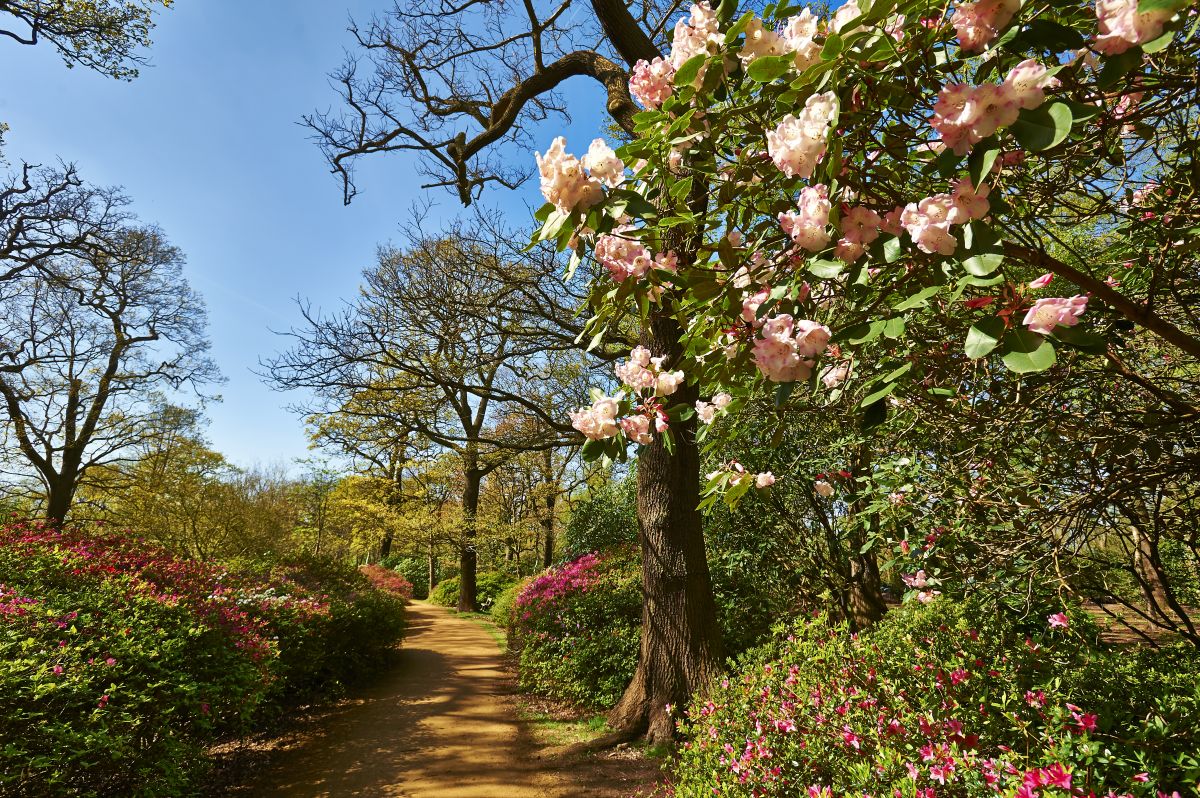
Situated within the 2,500 acre expanse of Richmond Park, London, and open all year round, The Isabella Plantation is a brilliantly well-kept secret that takes up 40 acres of the park and is maintained by The Royal Parks.
Before the beginning of the plantation in the 1830s, the area was boggy and unusable. After extensive rejuvenation it was then opened to the public in 1953. Since, the plantation has been immensely well cared for and continues to evolve year after year.
The plantations’ evergreen azaleas, which have a symbiotic relationship with the plantations’ native and exotic plants, attract many visitors every April to May, but the plantation is equally as beautiful in the autumn months too. Around October, the plantation is a beautiful blend of orange and red hues that should not be missed. Furthermore, due to the plantation being situated in the middle of the park, the plantation has a secretive aura and is rarely too busy.
While you are visiting the plantation, the rest of the park is worth a view too. The wildlife of the park is fascinating, with the surprisingly tame, wild deer that roam free, as well as the many breathtaking trails that look especially stunning covered in a magical morning fog.
The plantation is easily accessible, for wheel chairs too, despite being within a larger park. Enter by Peg’s Pond gate and Broomfield Hill Gate.
Lumley Castle, Durham

Set in a beautiful 600-year-old Lumley Castle, once the location of a murder, work alongside your friends and family on one its murder mystery nights. Although Lumley castle offers this ‘Motive for Murder’ event throughout the year, October is a particularly good time to take part, due to it being halloween.
Furthermore, situated near the city of Durham, Lumley Castle is a beautiful place to visit in the autumn. Warm and inviting on a chilly October day, the castle’s grounds are a beautiful setting for a brisk autumnal walk. Furthermore, the grade I listed building offers affordable, yet luxurious rooms to spend the night in and the chance to join them for an Elizabethan banquet.
While you are in the area, a quick trip into either the nearby cities of Durham or Newcastle will provide excellent day trips.
Seven Sisters, The Sussex Downs

Visit the Sussex Downs this October for a beautiful autumn adventure. The Sussex Downs is a National Trust country park that stretches all of the way from Eastbourne to Winchester. Although the Sussex Downs in itself is an excellent destination to visit this October, the striking sight of the chalk cliffs of the Seven Sisters, and the view form the top, is particularly unmissable.
For the best viewing point of the seven peaks themselves, walk along Seaford Head, a point along the South Down’s Way that runs adjacent to the sisters. The trail that passes Seaford Head not only provides an excellent walk through the Sussex Downs, but also provides a brilliant view of both The Sussex Downs, and also the Belle Tout Lighthouse.
REAM MORE: Britain’s top 10 autumn food festivals
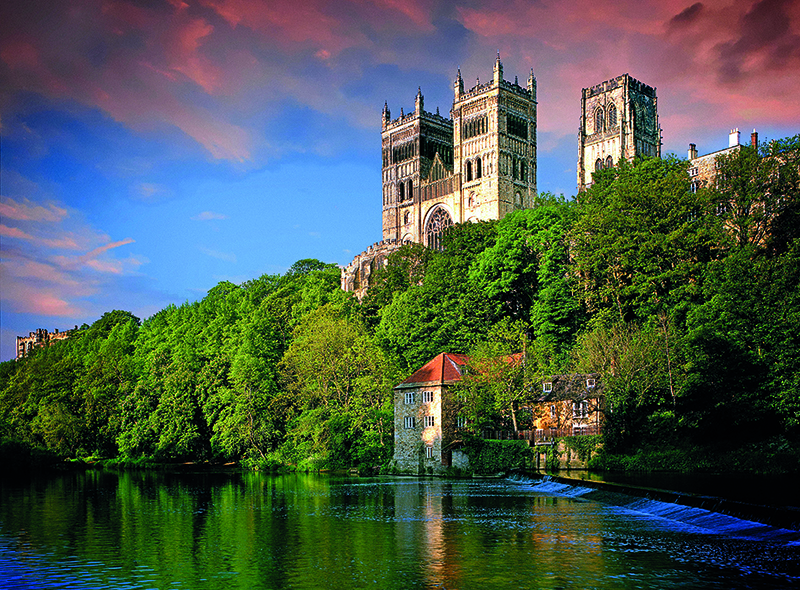
Your essential guide to Durham
The historic castle and cathedral are the undisputed stars, but this little city on the River Wear has plenty of surprises in store
Getting there
There are trains every half-hour from London King’s Cross to Durham; the journey takes approximately three hours.
Where to stay
For a central location stay at the quirky Victoria Inn, a small, traditional pub with comfortable rooms, friendly staff and bags of Northern character.
The larger Royal County has a similarly excellent location, spacious rooms and an indoor pool, sauna and gym.
The turreted, 600-year-old Lumley Castle, a 15-minute drive away, is the perfect choice if you’re looking for baronial grandeur. Some of the bedrooms come with four poster beds and turret bathrooms.
Where to eat and drink
The Cellar Door, down a flight of narrow steps, is a well-kept Durham secret. Come here for fantastic river views, as well as locally sourced treats, such as the Durham sirloin steak bake and Northumberland goat’s cheese soufflé. The absolute star of the show is the complementary, warm-from-the-oven bread served with freshly-churned butter at the start of your meal.
Half an hour south of Durham, but well worth the drive, is the two-star Michelin restaurant Raby Hunt. Run by chef James Close, this is a place for serious foodies, with a tasting menu of up to 15 courses. You can also stay the night.
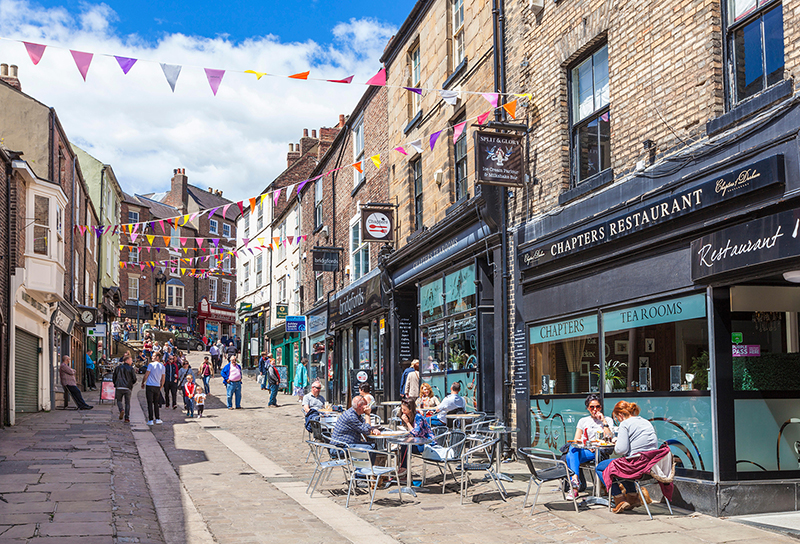
What to do
As well as the cathedral itself, take time to admire the adjoining cloisters (used as a stand-in for Hogwarts in Harry Potter and the Philosopher’s Stone) and visit the Open Treasure exhibition. This is on display in what used to be the medieval monks’ sleeping quarters, a lovely, light-filled space considered to be the best preserved monastic dormitory in Britain.
Today over 150 students live in the last Prince Bishop’s former residence, now University College. Guided tours of the college take in both the Norman and Tudor chapels as well as the Gothic Great Hall, still used as a dining room by today’s students.
Be sure to walk the full length of the Bailey, the narrow street that runs along the spine of the historic ‘island’ centre of Durham. At the sleepy south end it’s lined with elegant Georgian townhouses, many now housing university of offices and colleges, before leading steeply down to picturesque Prebends Bridge. At the north end the atmosphere is livelier, with busy cafés and shops. The Bailey leads into the Market Place (host to a bustling market every weekend, selling the best local produce), from where you can follow Silver Street downhill to Framwellgate Bridge, Durham’s oldest. Leaning over its stone parapets, you get lovely views back up the wooded hill to the castle, with the cathedral towers in the distance.
If you find yourself in Durham at November-time, be sure to catch Lumiere – the UK’s largest light festival takes over the whole city every autumn with spectacular and mesmerising displays of light and artistry. In 2023, Lumiere will take place from the 16th – 19th November. Book your free tickets here.
This is an edited version of an article from Vol 87, Issue 1. Order your copy here
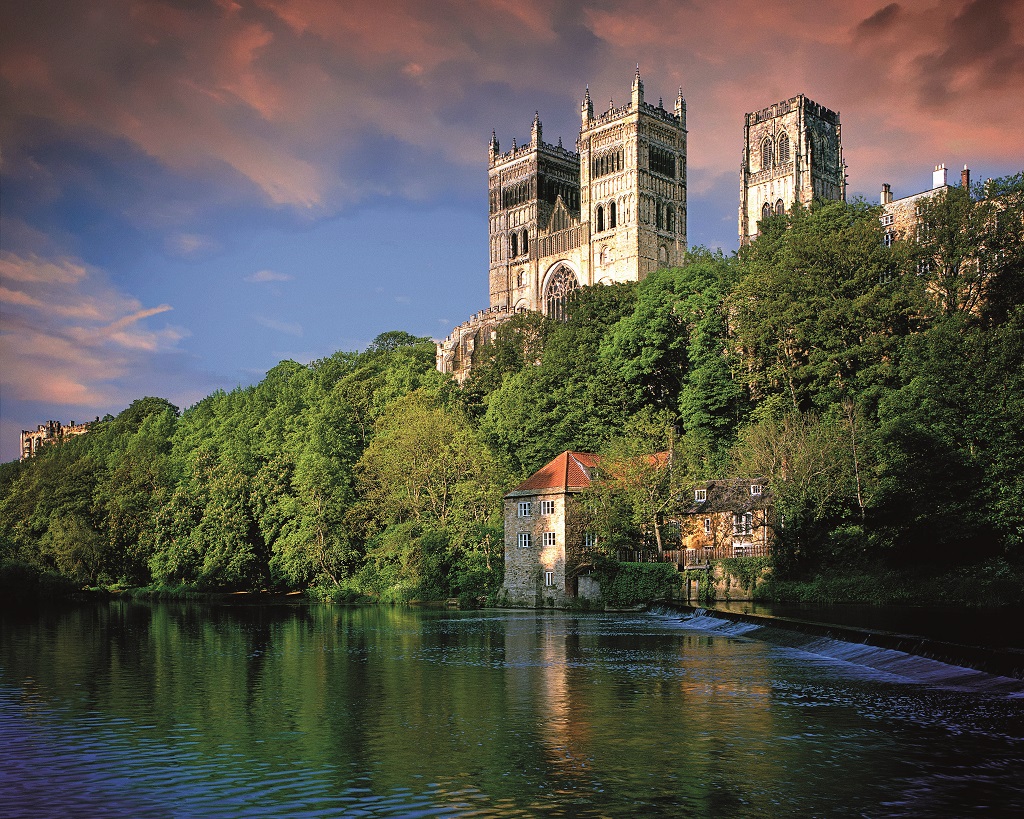
Land of the Prince Bishops: Explore County Durham
The northeastern county of Durham is full of remarkable treasures that tell the tale of 1,000 years of English history
The American writer and Anglophile Bill Bryson first visited on a whim, getting off the train at Durham station with the intention of having a quick look at the cathedral before heading on to his destination, Newcastle. But Durham was not to release him so easily. “I fell in love with it instantly in a serious way”, he wrote. “If you have never been to Durham,
go at once. Take my car. It’s wonderful.”
Many visitors overlook this enchanting city, merely glimpsing it from the train while shuttling between the tourist hotspots of York and Edinburgh. But Durham and its surrounding county boast compelling reasons to visit, not least the magnificent building that Bryson called “the best cathedral on planet earth”.
Durham Cathedral sits in a loop of the River Wear, a location chosen for the natural protection afforded by the high riverbanks on three sides and the proximity of the mighty Durham Castle. It was built to house the shrine of St Cuthbert, the Northeast’s most venerated saint, who had been a monk and a hermit on the isle of Lindisfarne; fleeing Viking raids, his followers had wandered England for seven years, carrying his coffin, in search of a suitable resting place. In this lofty, tranquil place they had finally found it.
Built in 1093, the cathedral is Europe’s supreme example of the Norman-Romanesque style, with a high vaulted nave and enormous stone pillars carved with Moorish-style geometric designs.
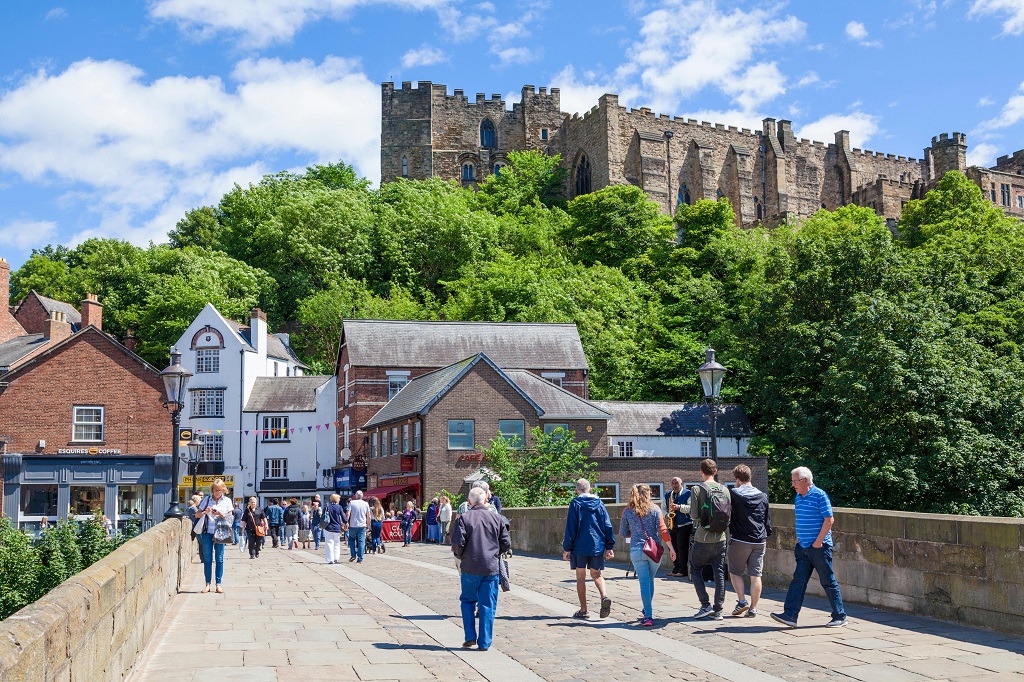
When Cuthbert’s coffin was opened 11 years after his death, it was discovered that his body was perfectly preserved. This, along with numerous accounts of miracles at the shrine, saw the emergence of a widespread cult that made Durham a major medieval pilgrimage site.
You can see St Cuthbert’s shrine – a simple marble slab that replaced a jewel-studded affair destroyed in the Reformation – behind the High Altar. Treasures including his decorated oak coffin and a dazzling gold-and-garnet cross found within his robes are in the cathedral’s museum.
Shortly after Cuthbert’s death, William the Conqueror, fearful of the marauding tribes that roamed the Scottish border, granted the bishops of Durham the special title of Prince Bishop. It was a rank that afforded them almost regal power: they were able to form their own parliament, command their own armies, levy their own taxes and mint their own coins.
In return, the Prince Bishops would keep the unruly North under control. Their power base was Durham Castle, built in 1072, which stands across Palace Green from the cathedral. The Prince Bishops poured their considerable wealth into the castle, which became a palatial residence. Tours take in highlights including the 17th-century Black Staircase and Norman Chapel, and tell the story of the rise and fall of the Prince Bishops, an astonishing reign of almost 800 years: temporarily subdued by Henry VIII’s Reformation, they clung to their powers until 1836, when they finally ceded them to the Crown.

In 1832 the last of the Prince Bishops approved the founding of England’s third university (after Oxford and Cambridge) in Durham. Like its more famous sisters, it maintains a residential college system, and the castle is now home to the lucky students of University College.
Below the castle and cathedral, the centre of Durham is charming. Cobbled streets run between Georgian townhouses, and ancient stone bridges span the picturesque River Wear, along which students lark about in rowing boats or stroll the wooded riverbanks.
This is an extract of an article printed in the latest issue of BRITAIN (January/February 2022).
To read the full feature, you can buy the issue here, or subscribe online to have every issue delivered right to your door.

Top 10 things to do in the British summer holidays
School’s out – great for your little ones but not so great for you once they start climbing the walls. Here’s our guide to some great British days out to make the summer holidays go smoothly
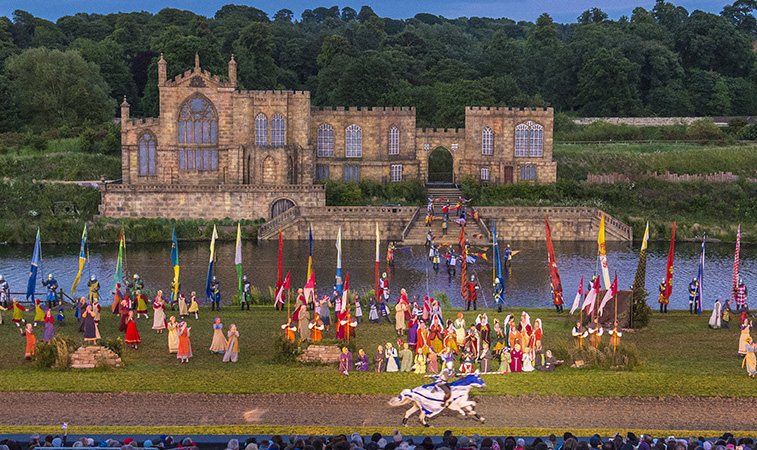
Kynren: a summer spectacular
Galloping Romans, flaming arrows, water-jets, cathedrals, mysterious ships rising from a dark, still lake. There’s only one word to describe Kynren: spectacular
What is it?
Taking inspiration from the extraordinary Puy Du Fou night pageant in the Vendée region of France, the show explores 2000 years of English history through 90 minutes of thrill-mongering stunts, gasp-worthy special effects, staggering pyrotechnics, a secret-concealing lake – and 1000 volunteer actors.
Where is it?
The rolling countryside around Bishop Auckland, County Durham, serves as a backdrop for everything from marauding Vikings to Queen Victoria’s Diamond Jubilee.
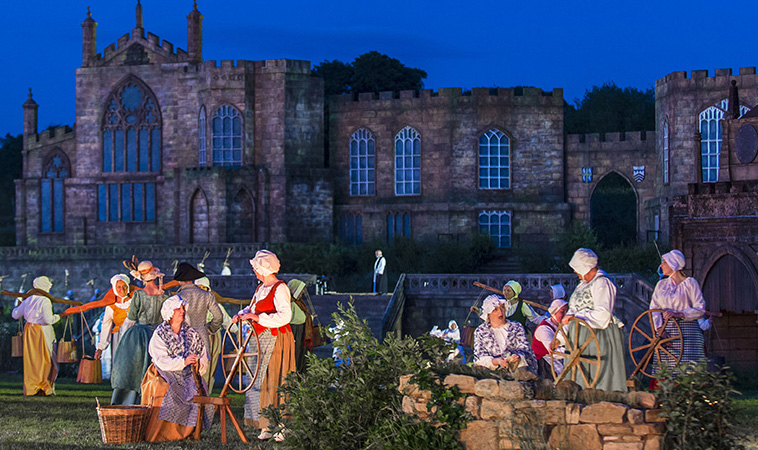
What can you expect to see?
For the first-timer, Kynren is a head-spin. Set-pieces appear and disappear, actors seem to be everywhere. Watching a battle, you turn your head for a second, glance back and a castle – or a long ship, or a time portal – has risen from the lake itself. The Venerable Bede walks across the water through swirling mists, Queen Elizabeth I arrives by barge, Stephenson’s Rocket chuffs across distant tracks.
A few feet from the front row, Boudicca and her daughters, Saxon invaders and medieval jousting knights thunder past, seemingly inches away. A Roman is dragged by a galloping horse to a sticky end while a Viking and his steed hurtle by, wreathed in genuine flame.

Is it all performed by volunteers?
Kynren, adapted from the Anglo-Saxon ‘cynren’, meaning ‘kindred’ or ‘family’, refers to the shared history of much of its audience, but even more to the camaraderie of 1500 dedicated individuals who work together every year to create something awe-inspiring. An army of highly-trained costumiers, prop-makers, stewards, divers, pyrotechnics teams and front-of-house staff supports 1000 performers and scores of scene-stealing animals. In a region with high levels of unemployment, this is skills-training at its most jaw-dropping.
So it’s local history?
Sort of. Kynren looks at English history through the eyes of the North East. St Cuthbert, Lindisfarne and Durham Cathedral all enjoy their moment in the spotlight, while King Harold’s arrow-in-the-eye at Hastings is put into context through his victory, a few days earlier, at Stamford Bridge.

Who will enjoy it?
This is solidly traditional fare, aimed at families. It will be great to see some diversity in the cast , something bound to happen as Kynren continues to grow, year by year.
Kynren runs for 17 performances throughout Summer 2018. For tickets and further information see www.kynren.com
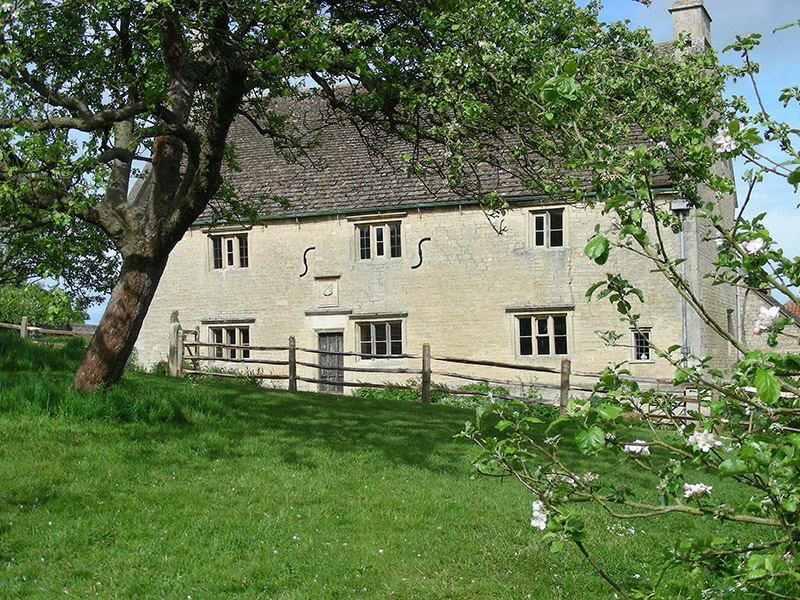
Revealed: Sir Isaac Newton drawing discovered on the wall of his Lincolnshire home after 350 years
A drawing by English scientist Sir Isaac Newton has been found etched into a wall at his childhood home, 350 years later
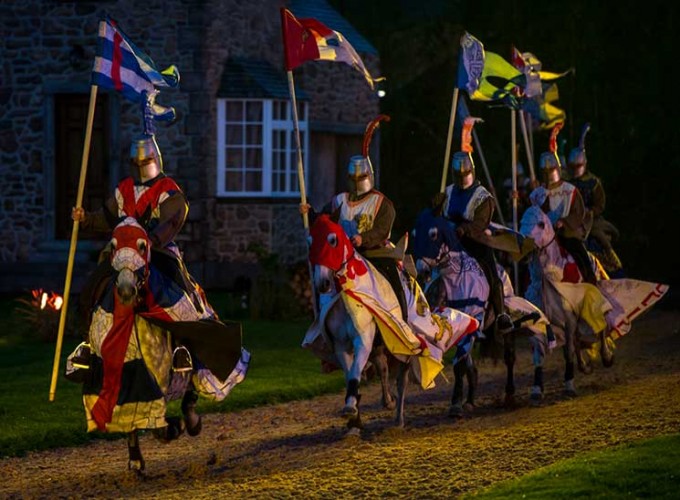
Discover Durham’s summer of culture
This summer, the historic city and county of Durham is showcasing its history and heritage like never before with a wealth of fabulous attractions.
